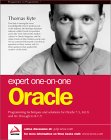
By: Thomas Kyte
Perfect Paperback - 1265 pages (June 2001)
Wrox Press Inc
Tom Kyte is of a rare breed. To begin, he's technically expert in his subject (administration of and development of applications for Oracle database management systems). What's more (and what distinguishes him from the ranks of the super-competent), he is both able and willing to share his considerable store of wisdom with Oracle users via books like Expert One on One: Oracle. Perhaps the best book about Oracle products ever put out, this book is a model of all aspects of technical publishing: s cope, level of detail, clarity of explanations, and quality of examples. It's pretty much certain that you will learn a great deal about Oracle from Kyte's work, and that you'll become more capable in your work as a result of studying this book. Kyte - it's very tempting to call him an Oracle oracle - seems not to have had to struggle to fit his message into the Wrox Press form, which relies on a running commentary interspersed with code listings and conceptual diagrams. Kyte's commentary is em inently informed and packed with references to the differences between that which is ideal and that which often must be done to accommodate reality. He takes care to explain how little-known pieces of the Oracle environment - and alternative ways of looking at the more familiar ones - solve problems, an approach that leads to elegant, efficient solutions. Kyte boosts his readers across the chasm that separates people who can write applications for Oracle databases from people who understand Orac le databases.
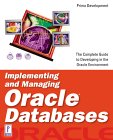
By: Steve Lemme, John R. Colby
Paperback - 418 pages (February 2001)
Premier Press, Inc
Oracle database administration goes far beyond installation and tuning of the database - topics covered by the majority of books on the market. As DBAs become more involved in the business process, architecture, and planning, there may be more to do up front, but the end result is less chaotic. To better prepare those who are up to the new eBusiness challenges, the chapters in this book have been organized with information to not only provide IT professionals with information that can be applied for a more challenging and successful career, but also for those companies who are trying to attract and retain them.
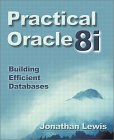
By: Jonathan Lewis
Paperback - 640 pages 1st edition (January 15, 2001)
Addison-Wesley Publishing Company
A lot of books seem to give canned explanations of how oracle works - geared towards rote memorization as opposed to understanding. This book does a great job of taking the next step. For example, The detail with which the author goes through the process of how updating a row actually works in an Oracle database was tremendous. His explanation of how a select statement could actually cause a row to be marked as committed ( i.e. a read causes a write ) was great. I've only been a DBA (or pseudo-D BA) for about 6 months now, so I'm certainly no expert in this area. Yet I found all of his explanations very clear and easy to understand. If you're looking for a new Oracle book, get this one.
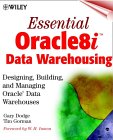
By: Gary Dodge, Tim Gorman, W. H. Inmon
Paperback - 928 pages 2 edition (September 6, 2000)
John Wiley & Sons
A soup-to-nuts guide to building and managing high-performance Oracle8i data warehouses In an effort to help companies manage what Information Week has referred to as the "Web Data Deluge," Oracle has released Oracle8i (the "i" stands for "Internet"), a major upgrade to their flagship database product that provides powerful new data warehousing capabilities. In this updated and expanded edition of their critically acclaimed Oracle8 Data Warehousing, Gary Dodge and Tim Gorman provide database dev elopers and administrators with complete, detailed coverage of all they need to know to build and manage a fast, high-performance data warehouse using the Oracle8i technology. Step-by-step, they cover all the bases, including designing a data warehouse for optimum performance, building a data warehouse, loading data into the data warehouse, improving warehouse performance with aggregate data, and administering data warehouse performance.

By: James Morle
Paperback - 544 pages (December 17, 1999)
Addison-Wesley Publishing Company
As open systems continue to replace traditional mainframe systems, system scalability is becoming an increasingly important topic. Although far more flexible than mainframe systems, open systems applications tend to be less reliable and more difficult to scale. There is no cookbook approach to solving this challenge: A thorough understanding of the technologies involved is essential for designing scalable solutions that meet long-term business needs. Scaling Oracle8i(tm) offers valuable insights and techniques for designing reliable and scalable online transaction processing (OLTP) applications using Oracle. This book focuses on providing the in-depth information about Oracle and the underlying hardware required to build systems that scale effectively. You will find coverage of relevant hardware and I/O operation; benchmark and database monitoring systems; Oracle internals, operation, and implementation; and UNIX operating system issues that impact Oracle performance and scalability.
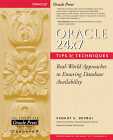
By: Venkat S. Devraj
Paperback - 1008 pages (November 1999)
Computing McGraw-Hill (Oracle Press)
Time-tested information--Strategies come straight from an Oracle DBA who's worked in the trenches for the Quatar Government keeping systems online 24x7. 8i Coverage--Version 8i's web functionality makes working in 24x7 mode available to a wider spectrum of corporations. Specific discussions--Covers areas of database installation, configuration, and management of security, performance, and recoverability. Diagnostic and database monitoring scripts--Scripts can be deployed immediately to help DBAs achieve high-availability databases.

By: Charles Dye, Deorah Russell (Editor), Deborah Russell (Editor)
Paperback - 530 pages Bk & Disk edition (April 1999)
O'Reilly & Associates
Most organizations that use the Oracle relational database management system (RDBMS) these days need to use multiple databases. There are many reasons to use more than a single database in a distributed database system: Different databases may be associated with particular business functions, such as manufacturing or human resources. Databases may be aligned with geographical boundaries, such as a behemoth database at a headquarters site and smaller databases at regional offices. Two different d atabases may be required to access the same data in different ways, such as an order entry database whose transactions are aggregated and analyzed in a data warehouse. A busy Internet commerce site may create multiple copies of the same database to attain horizontal scalability. A copy of a production database may be created to serve as a development test bed.
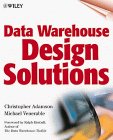
By: Christopher Adamson, Michael Venerable
Paperback - 544 pages 1 edition (June 29, 1998)
John Wiley & Sons
Data warehouses store millions of records, allowing managers to ask the big-picture questions about their businesses. The authors of Data Warehouse Design Solutions share their expertise in designing successful data warehouses and concentrate on understanding business processes within a variety of industries. First, the authors outline the promise--and potential hurdles--of data warehousing. They thoroughly explain the idea of dimensional data, which is used to represent the quantities or attrib utes that can be queried in a data warehouse. The authors argue that data warehouses need to adapt to changing business conditions and often must be more flexible than planned. They advise building the Enterprise Data Warehouse (EDW) as a series of interlocking data marts (which contain different dimensions). Developers can build part of a solution and add new data marts later. The result is a more adaptable approach to warehousing data. The heart of Data Warehouse Design Solutions is the descri ptions of data warehouses tailored to specific industries--sales, marketing, fulfillment, production, inventory, and capacity--using real-world businesses. The authors offer business models, sample dimensions, database schema, and sample reports for each business area. Later chapters discuss more advanced areas for data warehousing, including budget tracking, financial reporting (and managerial accounting), and even how to look at profitability and intellectual capital. The authors round out the ir nuts-and-bolts tour of today's businesses with a summary of the various measures that fit each type of organization. Finally, the authors come back to theory, with some ideas on building effective systems that are fast and that generate easy-to-read reports. The last chapter argues convincingly that their incremental approach to building data warehousing has some distinct advantages.

By: Steve Bobrowski
Paperback - 356 pages authorized edition (October 1997)
Osborne McGraw-Hill (Oracle Press)
The book design has two primary goals. First, the book is a basic/intermediate level presentation of the primary concepts and software architecture of Oracle8. After reading this book, any type of Oracle8 user will have a solid, big-picture understanding of how Oracle8 fits into the world of serious data management applications. Second, the book is an excellent planning guide that will help a current Oracle user server to migrate Oracle7 databases and corresponding database server administrators and application developers need to understand to work with Oracle8.